Disciplinary meeting minutes serve as official records of discussions, decisions, and actions taken during meetings addressing employee conduct or performance issues. These documents ensure transparency, legal compliance, and clarity…
continue reading
Download Community Meeting Minutes Bundle
Community Meeting Minutes Format
Date: [Insert date of meeting]
Time: [Insert start and end time]
Location: [Insert meeting location]
Facilitator: [Insert name of facilitator]
Note-Taker: [Insert name of note-taker]
Attendance: [List names or attach an attendance sheet]
Agenda
- [Agenda item 1]
- [Agenda item 2]
- [Agenda item 3]
- [Agenda item 4]
Meeting Proceedings
Welcome and Opening Remarks
- [Summarize key points or quotes from facilitator or chairperson]
Review of Previous Meeting Minutes
- [Briefly recap highlights or approvals from the last meeting]
Updates and Reports
1. Community Projects Update
- [Description of ongoing or upcoming projects]
- Responsible parties: [Names or groups]
2. Financial Report
- [Summary of budget, expenditures, or funding opportunities]
- Presented by: [Name]
3. Upcoming Events
- [Details of events, including dates and planning committees]
Discussion Points
Topic 1: [Insert topic name]
- [Key points discussed]
- Decisions made: [Insert decisions or agreements]
- Action Items: [List specific tasks and assignees]
Topic 2: [Insert topic name]
- [Key points discussed]
- Decisions made: [Insert decisions or agreements]
- Action Items: [List specific tasks and assignees]
Open Forum/Community Concerns
- [Summarize any new issues raised by attendees]
Decisions Made
- [List all resolutions or agreements reached in the meeting]
Action Items
- Action Item 1: [Task description] – Responsible Party: [Name/Group] – Deadline: [Date]
- Action Item 2: [Task description] – Responsible Party: [Name/Group] – Deadline: [Date]
Next Meeting
- Date and Time: [Insert next meeting details]
- Location: [Insert next meeting location]
Adjournment
- Time: [Insert time meeting adjourned]
Note: [Add any additional notes or follow-ups required.]
Community Meeting Minutes Samples
-

Youth Community Meeting Minutes
download now -

Joint Community Meeting Minutes
download now -

Community Policing Advisory Board Minutes of Special Meeting
download now -

Community Board on Police Meeting Minutes
download now -

Economic And Community Development Committee Meeting Minutes
download now -

Community Center Town Council Meeting Minutes
download now -

Community Path Project Meeting Minutes
download now -

Medical Community Meeting Minutes
download now -

Community Club Meeting Minutes
download now -

Playground Community Meeting Minutes
download now -
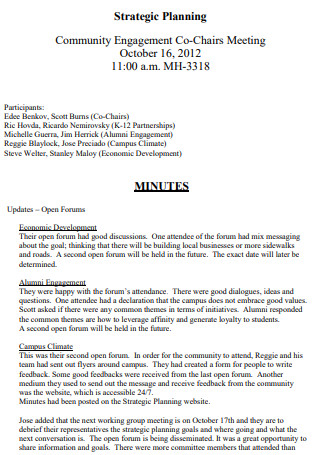
Community Engagement Co Chairs Meeting Minutes
download now -

College Park Project Community Meeting Minutes
download now -

Community Service Commitee Meeting Minutes
download now -

Community Supports Sub Committee Meeting Minutes
download now -

Community Engagement Meeting Minutes
download now -

Community Council Meeting Minutes
download now -

Sample Community Meeting Minutes
download now -

Community Supports Meeting Minutes
download now -

Community Development Commission Meeting Minutes
download now -

Community Enhancement Meeting Minutes
download now -

Approved Community Meeting Minutes
download now -

Community College Board Meeting Minutes
download now -

Still Mountain Community Meeting Minutes
download now -

Climate Smart Community Meeting Minutes
download now -

School Community Council Meeting Minutes
download now -

Community Colleges Committee Meeting Minutes
download now -

Community Outreach Meeting Minutes
download now -

Community College Board of Trustees Meeting Minutes
download now -
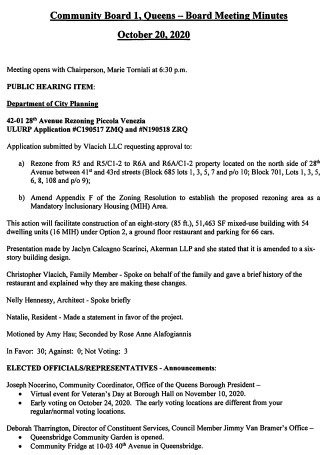
Community Board Meeting Minutes
download now -

Community Mental Health Board Meeting Minutes
download now -

Community Rural Health Advisory Meeting Minutes
download now -

Community Preservation Committee Meeting Minutes
download now -

Community Paramedicine Committee Meeting Minutes
download now -

Formal Community Meeting Minutes
download now -

Community School Regular Meeting Minutes
download now -
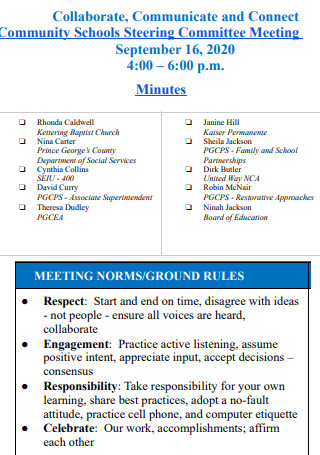
Community Schools Steering Committee Meeting Minutes
download now -

Community Planning Group Meeting Minutes
download now -

Community Meeting Minutes Example
download now -

Community Affairs Committee Meeting Minutes
download now -
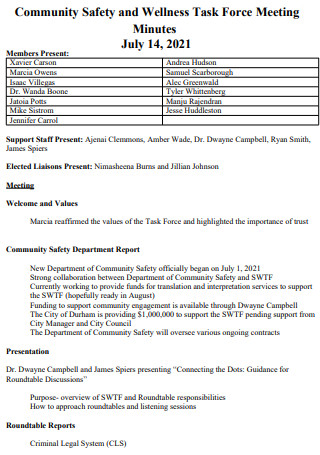
Community Safety and Wellness Task Force Meeting Minutes
download now -
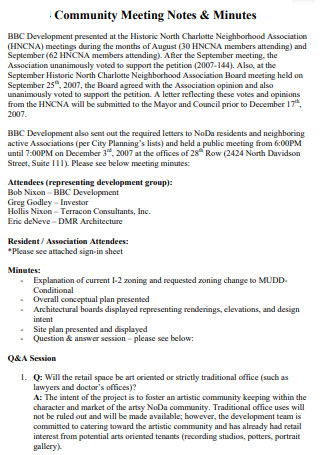
Community Meeting Notes And Minutes
download now -

Community Library Meeting Minutes
download now -

Community Oven Meeting Minutes
download now -

Executive Community Advisory Committee Meeting Minutes
download now -
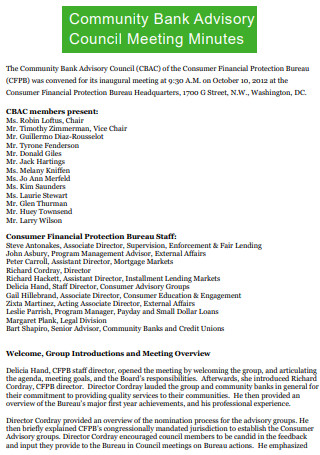
Community Bank Advisory Council Meeting Minute
download now -

Community Engagement Committee Meeting Minute
download now -
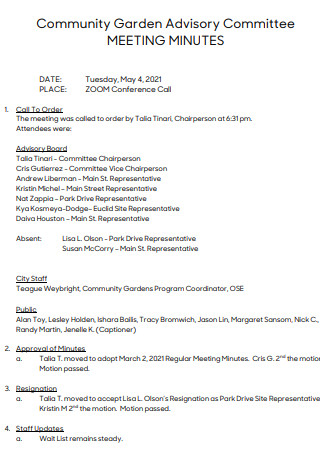
Community Garden Advisory Committee Meeting Minute
download now -

Community Association Meeting Minute
download now -

Community Academies Meeting Minute
download now -

Community Advisory Council Meeting Minutes
download now -

Community Corrections Advisory Board Meeting Minutes
download now -

Community Policing Advisory Group Meeting Minutes
download now -

Community Stakeholder Roundtables Meeting Minutes
download now
What is Community Meeting Minutes?
Community meeting minutes are written records that summarize the key discussions, decisions, and agreed-upon actions from a community meeting. They are typically prepared by a secretary or designated note-taker and aim to document everything from attendee lists to motions passed and resolutions made. Meeting minutes are used as an official reference for future discussions and ensure everyone remains on the same page. You can also see more on Training Meeting Minutes.
Elements of Planning a Community Meeting

A meeting that does not have a clearly stated and well-announced aim will have a low turnout. Remember that time is valuable to everyone, especially in small towns and villages. Informing citizens of what to expect from the meeting and what will be required of them would be beneficial.
How to Create Community Meeting Minutes

Step 1: Preparation Before the Meeting
Identify the purpose of the meeting and gather the agenda, list of participants, and necessary materials. Create a draft template for the minutes, including sections like date, time, attendees, and agenda items. Ensure you understand the expectations for the level of detail required. You can also see more on Research Meeting Minutes.
Step 2: Recording During the Meeting
Actively listen and jot down key points such as motions, decisions, and assigned tasks. Note who participated, who presented specific topics, and any votes or disagreements. Avoid recording unnecessary details; focus on the essence of discussions.
Step 3: Organizing Notes After the Meeting
Organize your raw notes into a structured format. Begin with basic meeting details, followed by a list of attendees, agenda points, discussions, and actions. Be concise yet thorough to avoid misunderstandings.
Step 4: Reviewing for Accuracy
Review the draft for completeness and correctness. Cross-check details with the meeting agenda and confirm specific points with participants if necessary. Editing for clarity is essential to ensure the minutes are easily understandable. You can also see more on Administrative Meeting Minutes.
Step 5: Sharing the Final Version
Distribute the finalized minutes to all participants promptly. Use email, a shared platform, or other agreed-upon channels. Ensure accessibility and allow for corrections or clarifications before storing the final version as an official record.
Community meeting minutes are vital for maintaining effective communication and transparency within any group. By documenting key discussions, decisions, and actions, they ensure alignment and accountability. Well-prepared minutes foster trust and provide a reliable record for future reference. Whether for formal or informal settings, mastering the art of meeting minutes benefits both the community and its stakeholders. You can also see more on Event Meeting Minutes.
FAQs
What Are the Minutes of a Meeting For?
Meeting minutes are the notes that are taken during a meeting to document what took place! In contrast to a meeting agenda, it serves as a record of the choices made and activities requested by the committee. Despite the team’s best efforts, they are not a minute-by-minute record, but rather a compilation of the most important details that the team will want to know.
What Makes a Good Setting for A Community Meeting?
A community gathering provides the ideal atmosphere for exchanging ideas and information since it brings together a diverse range of thoughts and perspectives. A successful meeting brings together a diverse group of engaged participants, during which information and opinions are shared, resources and volunteers are discovered, and goals and action plans are developed. You can also see more on Team Meeting Minutes.
What Should I Exclude from My Meeting Minutes?
This additional detail can aid in the establishment of a rebuttable presumption that the activity was reasonable, which can aid in the avoidance of the Internal Revenue Service penalty. Because minutes are public records that members may request to access, it is important to be clear about what should be excluded. Avoid direct quotations; even if the speaker isn’t identified, he or she may be able to be identified.
How can I ensure accuracy when taking meeting minutes?
Accuracy comes from preparation and active listening. Use a template to guide your note-taking, and clarify points during the meeting if needed. Post-meeting, review the notes for completeness and confirm with key participants. You can also see more on HR Meeting Minutes.
What’s the difference between formal and informal meeting minutes?
Formal minutes are detailed and follow a structured format, suitable for legal or organizational purposes. Informal minutes are concise summaries of discussions and decisions for general reference.
How detailed should community meeting minutes be?
The level of detail depends on the meeting’s purpose. For formal settings, include comprehensive information; for informal gatherings, summarize key points, decisions, and action items concisely. You can also see more on Faculty Meeting Minutes.

